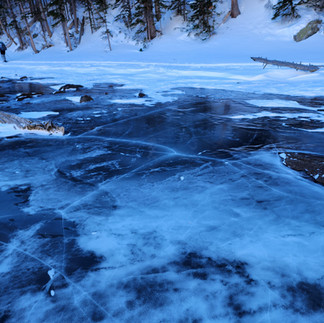Nymph, Dream, & Emerald Lake Snowshoe
Rocky Mountain National Park, Colorado, 2022
Snowshoeing is fun, right?
I traveled back to Colorado for several weeks at the end of 2022 and had one goal in mind: winter hike/snowshoe the Rockies. I'm super fortunate to have a friend in my old hometown who is as crazy as I am. This is our story:
We decided to tackle Nymph, Dream, and Emerald Lake at the end of November. We booked a hotel room in Estes Park for the night before our hike, that way we could get an early start. This trail is notoriously popular, year-round (it's so popular, you need a permit in the summer*).
One thing you can never count on in Colorado: the weather.
What was supposed to be a gorgeous, bluebird two-day trip with zero chance of snow turned into a "Whoa. Estes is getting dumped on right now. Do we still chance it?"
Spoiler Alert: we chanced it.
The drive to Estes Park was slow, snowy, and packed with multiple WTF moments. I always joke (but at the same time am deadly serious) that I'm not worried about driving in the snow, I'm worried about the other people on the road... and we had several close encounters with out-of-control drivers 🫣
When we finally made it to Estes Park, the snow had stopped and the storm clouds were breaking - yay! We decided to make a pit stop at The Stanley Hotel (you can't go to Estes Park and not visit this historic hotel) to take pictures at sunset. The hotel was dead, no pun intended. We had not anticipated being able to get a drink and meal at the famous Cascade Whiskey Bar located within the hotel, but snow storms. We cozied up to the bar and had a fabulous conversation with the staff, including their favorite ghost encounters while at work (no thanks). Reflecting back, it was a pretty magical experience to have the entire bar and hotel lobby all to ourselves. The bar staff even mentioned that they had never seen the place empty like that.
We checked the weather forecast that evening for the following day and saw that it was supposed to be clear, but cold. In my mind: clear day = crowded day. So, we planned to be to the trailhead by 7 AM.
What we did not expect: an empty parking lot.
Now, I've snowshoed before, a handful of times, and obviously love it. But never have I ever had to break trail in shin-high snow, and up to waist-high in multiple sections. It was one of the most physically demanding things I have done, and at an altitude that I'm not used to. Also, you can't see rocks that are buried by snow... so yeah, I might have fallen once or twice and used it as an excuse for a quick rest 🤫
*Planning a trip to Rocky Mountain National Park this summer? Make sure to get your permits! And yes, they limit the number of park entries during the summer months. So no, you are not going to just roll up to Rocky's entrance gates and get in, sorry!
TRAIL DEETS

Length: 3.2 miles
Elevation Gain: 702 feet Max Elevation: 10,127 feet
Route Type: Out and Back
AllTrails Difficulty: Easy
Pups: You'll need to leave your pups at home, dogs are not allowed in Rocky Mountain National Park.
Important: most trail difficulty ratings are determined when the trail is clear from snow and ice unless those conditions are present year-round. Hiking (snowshoeing) in the snow is a high-exertion activity (think walking or running in sand) and the trail conditions greatly influence the difficulty. Hiking on a hard-pack snow trail (the trail is visible and free from fresh snowfall) is significantly easier than hiking in deep snow. Breaking trail requires an enormous amount of energy and most people are lucky to make it 5 miles in deep, heavy snow.
DARCY WANDERS' ROUTE
I downloaded the navigation for Emerald Lake Trail from AllTrails and we referred to the navigation often (the existing packed trail was buried under 12+ inches of fresh snow). We decided to take a quick detour at the very beginning of the hike and view Bear Lake, which was (you guessed it) buried under snow. While we were worried the other lakes might be buried, we headed off toward Nymph Lake.
WARNING: Frozen Lake Crossing. The navigation provided from AllTrails is the summer path, which goes around Dream Lake. We attempted to follow the summer path, but quickly found ourselves caught in waist-high (chest-high for my friend) snow drifts. I remembered reading that the winter route crosses the frozen lake, but was hesitant to walk out on Dream Lake with it only being the end of November. While we continued along the summer path, we observed another couple successfully cross Dream Lake. We decided to risk it and cross the lake 🫣 Check out my Make It Great (Tips, Tricks & Gear) section for tips to help you cross a frozen lake safely.
Trail Popularity: We only saw a handful of people making our way back from Emerald Lake to Dream Lake, but passed numerous people from Dream Lake to the parking lot (it had turned into a beautiful day). Emerald Lake is the most popular hiking trail in Rocky Mountain National Park during peak season, requiring a Park Access+ from May 26th through October 22nd AND a Reservation between 5am and 6pm. For more details, visit the RMNP Timed Entry Permit System website.
GETTING THERE
The easiest way to get to the Emerald Lake trailhead is to use the navigation system of your choice with your destination set as either Emerald Lake or the Bear Lake Trailhead. Again, this is an incredibly popular trail and you will be required to show your Park Access+ and Reservation at the gate for Bear Lake Road from May 26th through October 22nd between 5am and 6pm.
This trail is located in Rocky Mountain National Park, which has entrance fees ranging from $15 (walking into the park) to $35 (vehicle for a 7 day pass [$30 for a 1 day pass]). I always highly recommend purchasing an annual America the Beautiful pass - each pass covers entrance fees at lands managed by the National Park Service and US Fish & Wildlife Service and also standard amenity fees (day use fees) at lands managed by the US Forest Service, Bureau of Land Management, Bureau of Reclamation, and US Army Corps of Engineers. A pass covers the pass owner and all occupants in a personal vehicle at sites that charge per vehicle or, the pass owner and up to three additional adults (16 and over) at sites that charge per person.

MAKE IT GREAT (TIPS, TRICKS, & GEAR)
Pick the Right Snowshoes. There are 3 basic categories for snowshoes: flat terrain, rolling terrain, and mountain terrain. If you are going to invest in a pair of snowshoes, then I recommend spending the extra money on a mountain terrain pair (yes, you can use these on all 3 terrain types). I also recommend purchasing a pair that include heel lifts, which help reduce fatigue and increase traction on steep sections. The overall design of snowshoes varies depending on the brand and the final decision comes down to personal preference. Darcy Wanders' Recommendation: I flew down a steep section one time in a pair of snowshoes that only had crampons located under my feet. Once was enough for me, it was terrifying. I got home that afternoon and researched the various snowshoe designs and settled on a pair of snowshoes from MSR's Ascent collection. Snowshoes in this collection are designed with crampons located under your feet and either steel traction rails or aggressive perimeter teeth. No more snowshoe skiing for me!
Don't Forget your Neck Gaiter. You are going to work up a sweat snowshoeing up to Dream and Emerald Lake, but the wind chill at the lakes is no joke. Make sure you throw your neck gaiter or balaclava on - your cheeks and nose will thank you!
Moisture-Wicking is Key. Make sure that you are wearing base layers that have both moisture management and temperature regulation. You definitely do not want to be on the trail in clothes that do not dry once they become damp from sweat: once you become chilled, you will not get warm again. Cotton is not your friend.
Layer Down for Travel. Don't start your hike off already sweaty from the car ride, your body is going to have to work extra hard to regulate your temperature. I generally travel to and from the trailhead in either just my baselayers or in my baselayers with a tee and lightweight joggers on over the top.
Pack Hot Chocolate. Treat yourself at one (or all!) of the lakes with a cup of hot chocolate. There are a ton of insulated containers on the market today, but my favorite is the BRUMATE Winesulator: it's 100% leakproof, has a lifetime warranty, and has a 24-hour temperature retention. Plus, it holds a full bottle of wine, which is a lot of hot chocolate!
TIPS TO HELP YOU CROSS A FROZEN LAKE SAFELY:
Check the Ice Conditions. Before crossing a frozen lake, it's important to check the ice conditions and thickness. This will help you determine whether it's safe to cross and how to plan your route. You can use a specialized ice gauge or measure the thickness yourself by drilling a small hole in the ice and checking the depth with a measuring tape. Check with Locals: Ask land managers or outdoor shops and guides about current ice conditions. It’s good intel, but keep in mind that ice thickness can change quickly as temps rise and fall.
Tread Lightly. Wear skis or snowshoes to help distribute your weight over the ice. In a group, keep your distance from others (about 50 feet). That way, if someone falls in, others are less likely to go under, too.
Plan your Route. When crossing a frozen lake, it's important to plan your route in advance and to choose a path that's as direct and safe as possible. Avoid areas with open water, pressure ridges, or cracks in the ice, and be aware of any obstacles or hazards along the way.
Study the Color. Clear ice with a bluish tint is the safest. White, milky ice is a sign of melting and reforming ice, which leaves air pockets that weaken it. While such ice can be passable, it’s not preferred (especially if covered in snow, insulating the ice beneath). Don’t tread on dark, thin ice.
Survive a Plunge. If you fall through the ice, remain calm and keep your clothes on, as they can help you float to the surface (but skis/snowshoes are a hindrance; jettison them). Swim toward the spot you fell in, get your hands and arms on the ice, and kick vigorously with your feet. Use your ice claws or ice axe to gain traction. Pull yourself onto the surface, lie down, and roll away from the weak ice. Seek shelter, dry clothes, and hot drinks immediately.






























Comments